

As 2019 unfolds, one question is likely on most investors’ minds: Is the bull market that began in March 2009 dead, or can it find its footing on less stable ground?
Last year brought on major waves of volatility, and the Dow Jones Industrial Average (DJIA) posted its worst December since the Great Depression year of 1931. With this much uncertainty, equity investors might think it is time to throw in the towel.
The DJIA index closed the year at 23,327.46, down 5.6% in 2018, after in 2017 it finished up about 25%. Similarly, the Standard & Poor’s 500 index finished 2018 down 6.2%, after gaining more than 19% the previous year. An alternative calculation for the Dow, represented by the so-called Diamonds ETF (DIA), in an effort to include the ever-important dividends, lost 7.4% in 2018.
Asking whether the bull market is dead will not yield any clear answers. Each year 24/7 Wall St. conducts an annual review of the 30 Dow stocks to forecast how the market as a whole would perform in the year ahead. This year, the analysis has provided a somewhat contrarian outlook, especially in light of recent market volatility and expected headwinds in 2019.
This approach of considering consensus price targets for each of the 30 Dow stocks has yielded a preliminary target of 28,000 for the DJIA in 2019.
There are many forces that could affect financial markets, the economy as a whole, as well as each stock. The markets will have to contend with the United States resolving international trade issues with China, a continued tempering of trade hostilities within the old NAFTA, Brexit, a Federal Reserve that wants to keep raising interest rates, and a potential inversion of the yield curve.
24/7 Wall St. has some serious concerns entering 2019 in using an analyst-driven consensus forecasting model alone, even if it has been useful in prior years. It is likely that many analysts have yet to take into account broader headwinds and have not yet adjusted down their price targets accordingly, especially considering how far off their highs many of these company stocks closed at in 2018. Still, a preset model is merely a means of calculation, and it allows investors to judge the state of the overall market.
With a projected price increase of 20.2% on top of the 23,327.46 close of 2018, the current model forecasts the Dow would rise to 28,039.60 in 2019. Let us call it 28,000 for rounding purposes. Considering dividends in the implied upside calculations, the Dow would climb 22.8% to 28,669.

1. 3M: Pain in 2018 after solid 2017
3M Co. (NYSE: MMM) proved in 2018 that the 31.0% gain in 2017 was too far and too fast. The stock lost 19.0% of its value in 2018. Conglomerates are no longer that popular, and 3M, too, dealt investors some pain when it lowered earnings guidance later in 2018. The diversified technology company was still able to keep growing its dividend, and that is likely to continue. 3M shares closed out 2018 at $190.54. The $203.94 consensus target price is lower than where the stock traded a year ago and implies an expected gain of about 9.9% when including the 2.9% dividend yield. 3M ended 2018 valued at almost 21 times trailing earnings, but just 17.6 times next year’s earnings estimate.
[in-text-ad]

2. American Express: What will credit card metrics do in 2019?
American Express Co. (NYSE: AXP) stock finished 2018 trading at $95.32 a share, down 4% from a year earlier. One reason there may have been some pressure on the credit-card company’s stock last year — outside of the overall plunge in financial stocks — was the shares’ surprising 34% in 2017. Such gains tend to rob future increases. Amex has a consensus target price of $114.94, for an implied expected gain of about 20% for the year, or 22% when including its 1.6% dividend yield.
Warren Buffett’s Berkshire Hathaway Inc. (BRK-A/BRK-B) continues to remain the anchor shareholder of American Express. The company needs to make certain its investors do not see eroding credit metrics with rising delinquencies and charge-offs in 2019. Interestingly enough, the consensus target price is less than 0.4% above Amex’s 52-week high.

3. Apple: Reached $1 trillion, then tanked
Apple Inc. (NASDAQ: AAPL) managed to become the first $1 trillion company by market cap in 2018. Unfortunately, CEO Tim Cook decided to stop breaking down individual sales metrics for the technology company, and that spooked and confused analysts. More than a handful lowered their iPhone sales estimates late in 2018 as well as their price targets on the stock. Apple shares fell by almost 7% in 2018, versus a 46% increase in 2017. Apple closed 2018 at $157.74 a share, and the consensus target price of $218.78 implies an expected gain of 40%, without considering the stock’s 1.9% dividend yield. That seems like a crazy-high target, but the share drops have been faster than analysts had time to adjust their targets. It is likely that more analysts will continue to dial back their estimates. Apple got off to a bad start in 2019, plunging 10% on Jan. 3 after it warned it will miss its quarterly sales forecast because of flagging growth in China as well as ongoing trade concerns. Apple’s warning reinforced investor anxiety about the company that analysts have been overly optimistic about earnings.
That said, Apple’s all-time and 52-week high is $233.47, and the company is using that unbelievable mountain of cash to aggressively buy back its own stock. For Apple to resume its impressive gains of yesteryear, it seems that Cook and his research and development teams  are going to have to drum up a new line of business that enthralls the masses (and it is probably not just another watch or wireless earpiece).
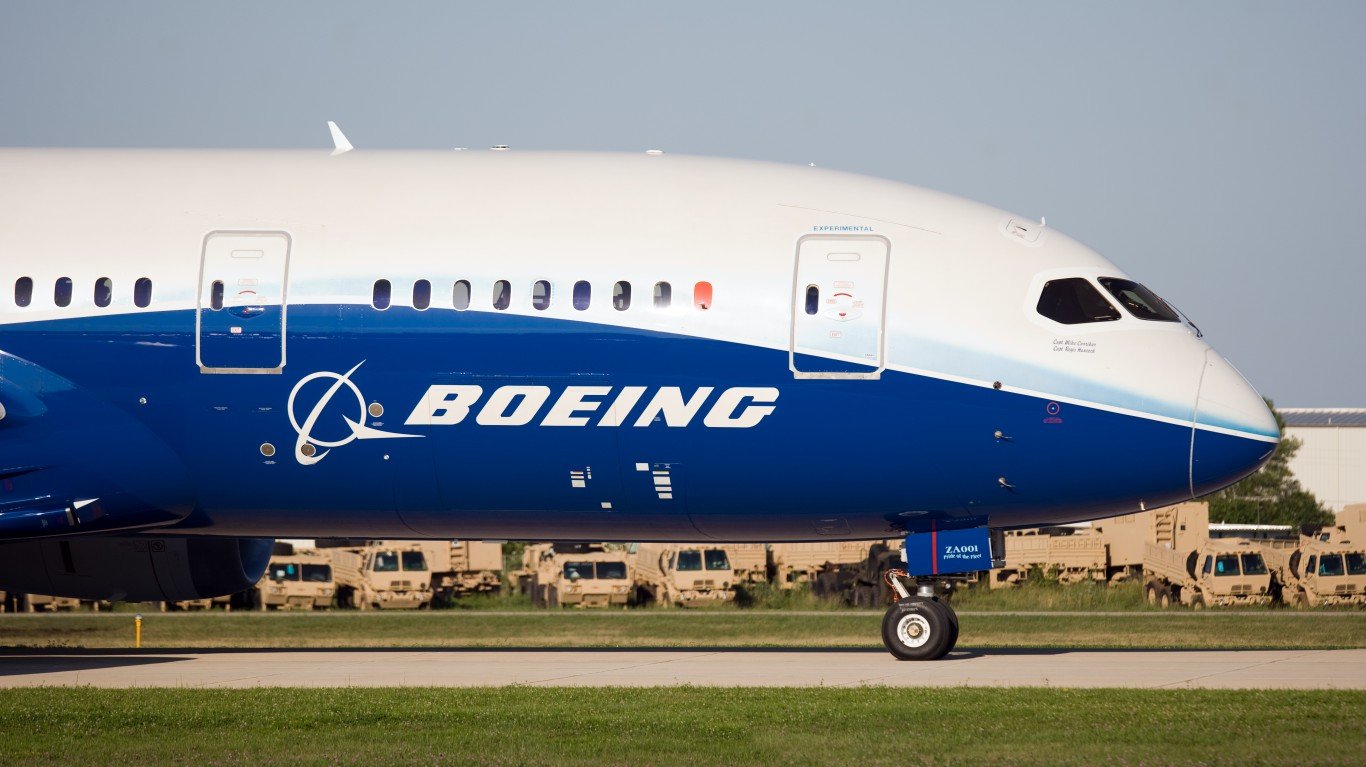
4. Boeing: Beyond boom-bust cycle
Boeing Co. (NYSE: BA) shares pulled back sharply in late 2018 but the shares of the aerospace giant still managed to squeeze out a gain of more than 9% last year. That was after soaring 89% in 2017, a gain that blew out the mere 4% expected by analysts. Changing hands for $322.50 per share at the end of 2018, Boeing stock has a consensus analyst target of $417.60 that would imply a gain of almost 30% — without even considering the stock’s 2.5% dividend yield. Boeing is also the highest weighted of Dow stocks, with more than 9% of the whole index weighting, so its implied gains matter heavily for the overall direction of the Dow in 2019.
Boeing’s market cap was $183 billion at the end of 2018, and its trailing price-to-earnings (P/E) ratio is 21.0, versus a forward P/E ratio of 17.5. Boeing is increasing production where it can to eat away at the near-6,000 plane orders counted in its backlog. Boeing has to overcome its  airline crash exposure in 2018, and it needs to continue to do well in aerospace and defense orders from the United States and its allies. The company’s trade exposure to China might not be helped if the so-called “revenge tariffs” come back against the company’s sales in China. On Jan. 3, the firm R.W. Baird maintained that Boeing is one of its top picks, but the company did lower earnings expectations after noting that plane deliveries in the fourth quarter of 2018 were likely to have been short of expectations.
[in-text-ad-2]

5. Caterpillar: Can Caterpillar overcome international challenges?
Caterpillar Inc. (NYSE: CAT) stock lost over 19% of its value in 2018, but that was after having soared 70% in 2017. This was another instance in which the excitement went too far. Now, the manufacturer of earth-moving equipment is in the midst of trade disputes and international strife in emerging markets. It is valued at 12.4 times trailing earnings and just 9.8 times expected earnings for 2019, but some investors are concerned that Caterpillar will have a hard time hitting its targets during such uncertain times.
With shares at $127.07 at the end of 2018, the consensus target price of $156.10 implies an expected return of almost 23% before considering the stock’s 2.7% dividend yield. That target price is also still well short of the 52-week high of $173.24.
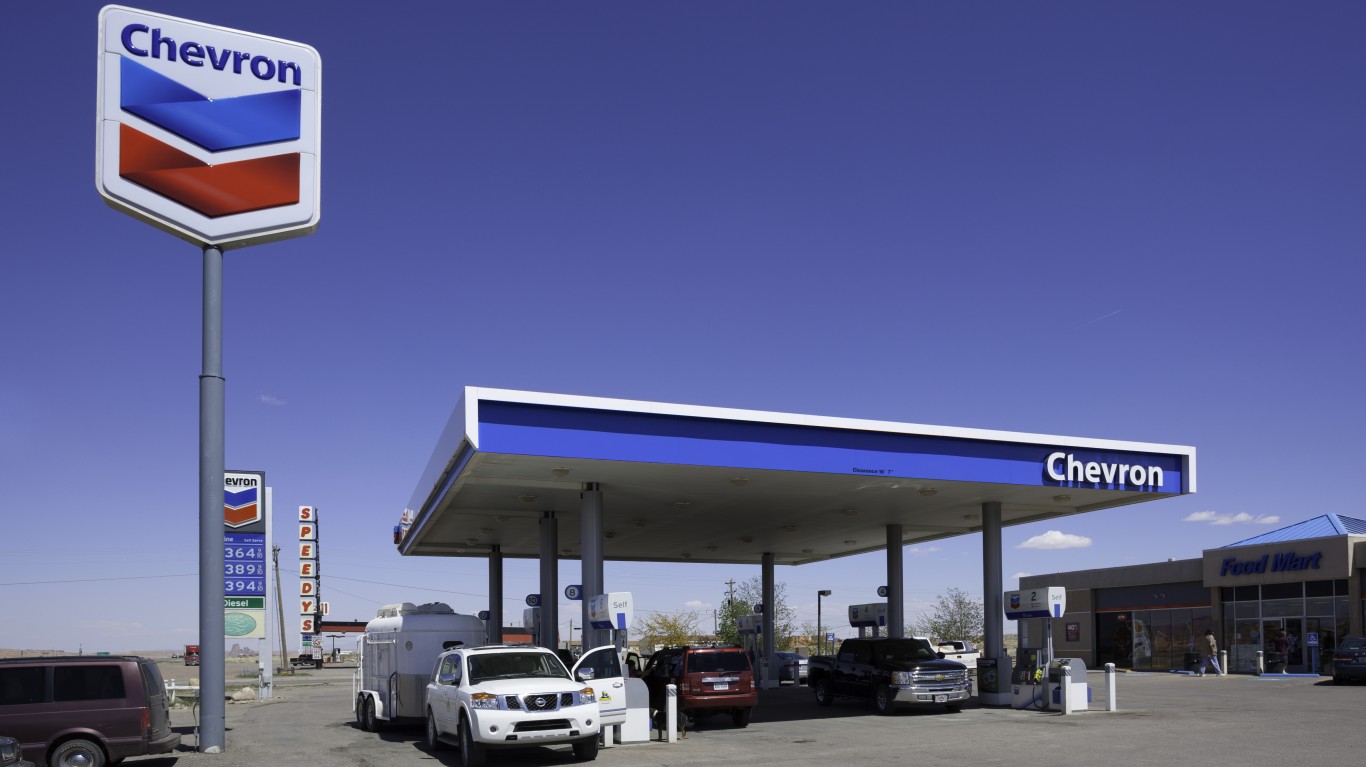
6. Chevron: Beyond better metrics and capex with lower oil prices
Chevron Corp. (NYSE: CVX) stock fell by 13% in 2018 as oil prices plummeted. Yet even the energy company’s shares did not necessarily track oil prices when they trended higher earlier in the year.. With shares trading at $108.79 to end the year, the consensus target price of $141.19 seem a bit suspect. Could Chevron really see its shares surge almost 34% in 2019, after considering its 4.1% dividend yield? It seems fair to expect that more analysts would cut their price targets on the stock in 2019, as oil is facing less optimistic prospects entering 2019 than last year. Further, more state pensions, endowments, and institutional investors could to turn their backs on fossil fuels in favor of sustainable investing. Chevron may need continually higher oil prices to get shareholders interested again.
[in-text-ad]
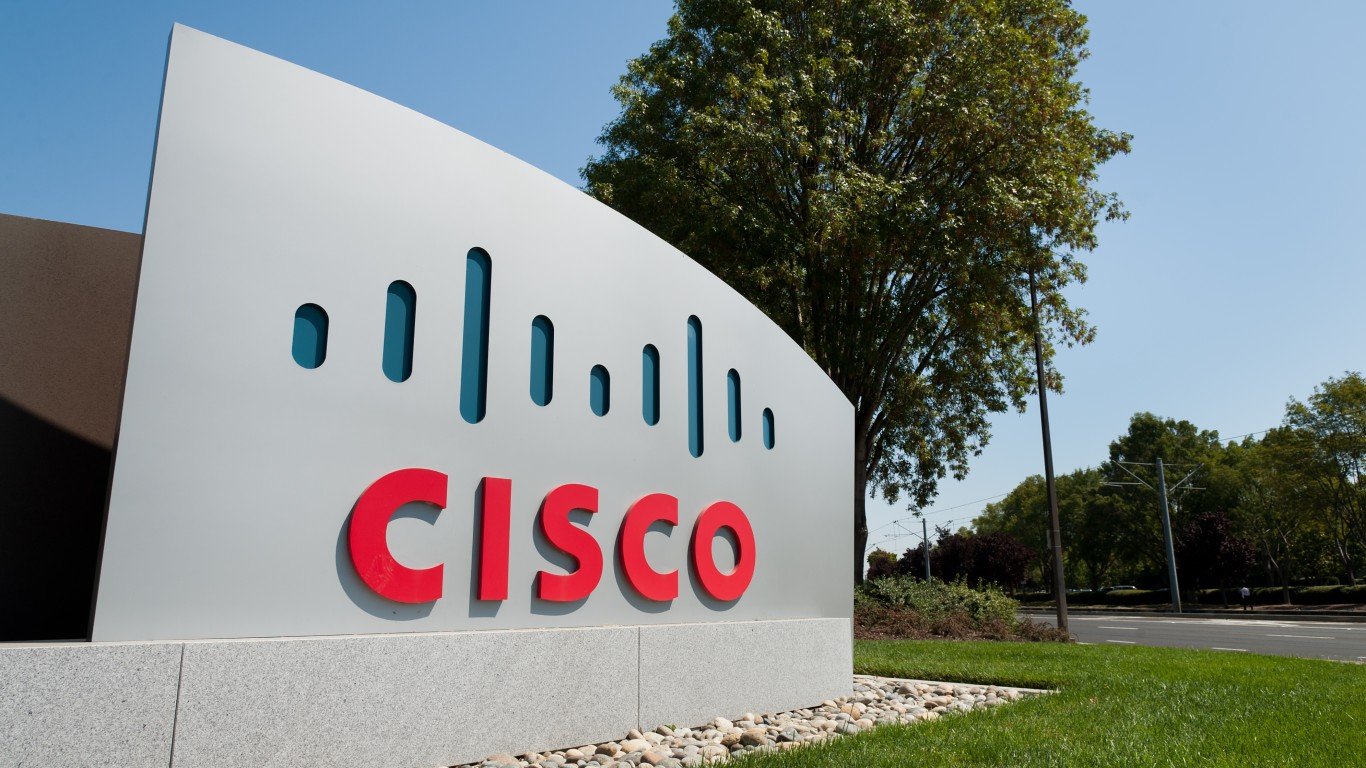
7. Cisco Systems: Stronger, but short of all-time high
Cisco Systems Inc. (NASDAQ: CSCO) managed to beat analyst projections and gain 13% in 2018. Analysts had only forecast a 4.65% gain for 2018. The 2018 return is down from a total return of about 26.7% in 2017 and the share price at the end of the year was valued at 17 times trailing earnings and less than 14 times forward earnings. Even considering that Cisco has retired billions worth of stock via buybacks, the market cap is less than $200 billion.
The networking company has moved away from just equipment sales and more toward services, security, and generating recurring revenue. It also has significant exposure to markets in China and elsewhere that could suffer if the global economy continues to slow. Cisco closed out 2018 at $43.33 a share. It has a 52-week range of $37.35 to $49.47, and the consensus target price of $52.76 would imply a gain of 21.7%, before even taking the stock’s 3.1% dividend yield into consideration. All that considered, Cisco accounted for just 1.2% of the Dow’s weighting, the lowest of all 30 components.

8. Coca-Cola: Moving beyond just Coke
Coca-Cola Co. (NYSE: KO) had managed to get its share price up to a level that was considered a technical breakout before the market volatility came into play heading into the end of 2018. The share price for the beverage giant of $47.35 at the end of 2018 generated a gain of just over 3% for the year, and the $51.66 consensus target price is above its 52-week and all-time high of $50.84. If analysts are correct, Coca-Cola could return 9.1% in appreciation, and the total return would be 12.4% after taking its 3.3% dividend yield into account. Analysts had been looking for a 10.1% return in 2018, with analyst consensus price target at $49.06 at the start of 2018, but the overall stock market selloff appears to have held it back.
Coca-Cola is rather defensive by nature, so it may hold up well if markets move erratically in 2019. Also, the company keeps making investments away from its old carbonated sugar-water products. One factor to consider is that Coca-Cola shares are valued at 21 times forward earnings. The beverage giant also can still point out that Warren Buffett and Berkshire Hathaway are major long-term shareholders and have not sold any of their shares.
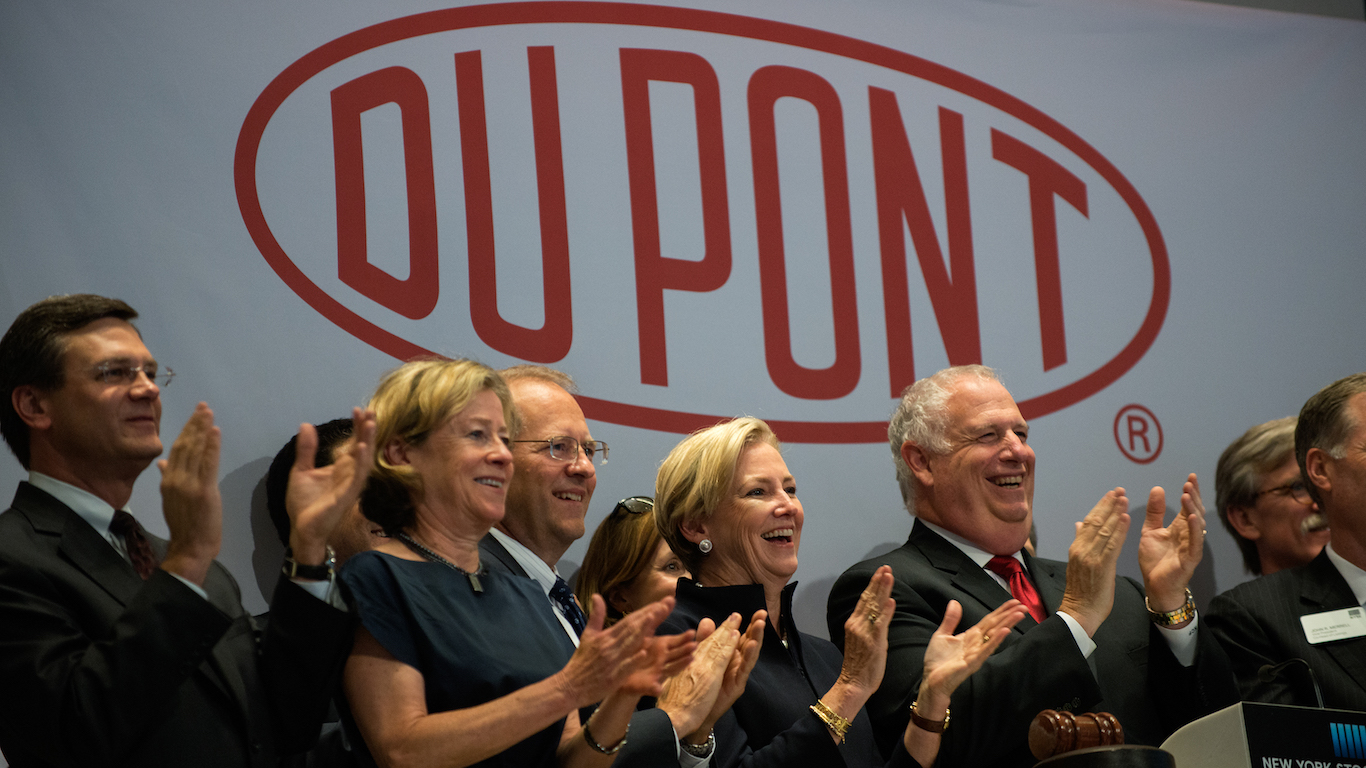
9. DowDuPont: More breaking up to do
DowDuPont Inc. (NYSE: DWDP) is the result of a merger between Dow Chemical and DuPont in 2017, so its performance over the course of 2017 is being excluded. Analysts were expecting gains of over 16% in 2018, but the slowing economy for industrials and companies with major exposure overseas created a loss in the stock value of nearly 25%. At $53.48 a share at the end of 2018, the stock has a 52-week range of $48.89 to $77.08 and comes with a consensus target price of $74.96, which implies an expected gain of about 40%, before even considering its 2.8% dividend yield.
Further complicating any predictions relating to DowDuPont is that the chemicals giant is expected to split itself into three companies. Analysts have a difficult time properly forecasting a company’s future financial performance when units are being pulled out, carved up, or added onto. That leaves DowDuPont on its own, and investors are betting on faith and promises more than they are on a future structure they do not fully understand.
[in-text-ad-2]

10. Exxon: Can nat-gas finally pay off?
Exxon Mobil Corp. (NYSE: XOM) stock declined 18.5% in 2018, and that was after a drop of 7.3% in 2017. The energy behemoth needs higher oil prices — just about anything tied to oil was hammered down in 2018. With a year-end close of $68.19 a share and a 52-week trading range of $64.65 to $89.30, Exxon’s consensus target price of $86.51 would imply a return of almost 27% in 2019, even before considering its 4.8% dividend yield. Exxon may have a win as natural gas exports can help the company more than many of the other oil giants. That would vindicate the company’s much criticized natural gas acquisition of XTO Energy in 2010. Still, Big Oil faces a challenge in bringing in new investors, and that is an industry-wide problem.
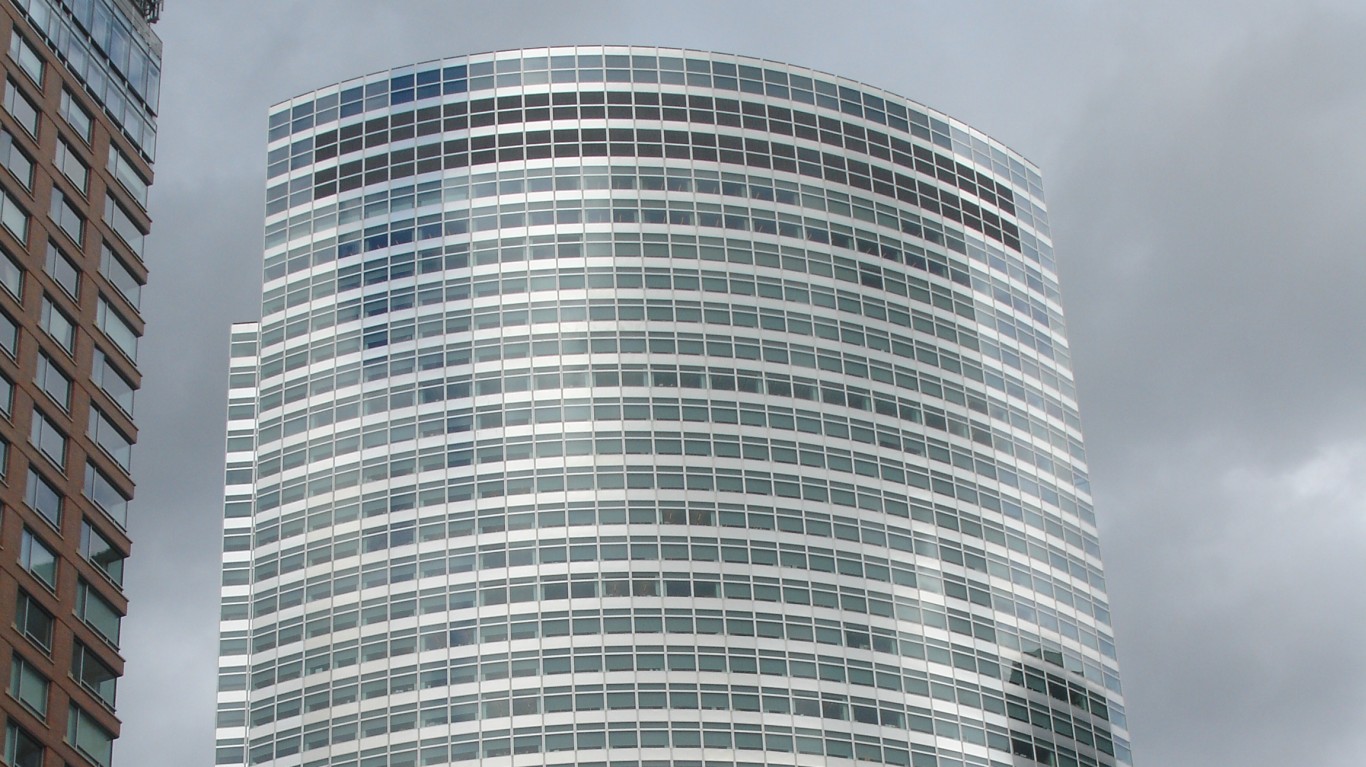
11. Goldman Sachs: Can the ‘Golden Slacks’ image return?
Goldman Sachs Group Inc. (NYSE: GS) has found itself in the midst of international scandal and domestic investigations again, and new CEO David Solomon does not seem to want to communicate to the public and investors as often as former CEO Lloyd Blankfein did. After a small gain of 6.4% in 2017, the bank’s stock lost about 34% of its value in 2018. It is supposed to be the top investment bank for the wealthy and institutions, but the firm wants to  expand its Marcus online banking platform to include the masses and younger clients.
After closing 2018 at $167.05 a share, and with a 52-week range of $151.70 to $275.31, consensus analyst estimate is still somehow all the way up at $253.30 as of the end of 2018. That would imply upside of 51.6% before considering its 1.9% dividend yield. The consensus price target had been up at almost $275 at the start of November, but this seems like another situation in which analysts have likely yet to fully adjust expectations and lower the target prices enough for 2019. Goldman Sachs historically traded at a premium to its book value, but it was down at about 0.8 times book at the end of 2018.
[in-text-ad]

12. Home Depot: Housing tailwinds become headwinds
Home Depot Inc. (NYSE: HD) share price managed to drop over 9% in 2018, after generating a stellar return of over 41% in 2017. Analyst expectations were only for a 3% gain or so in 2018, but the slowdown in housing, some pressure in retail, and even some fears of a decline in consumer confidence ahead all weighed on the home improvement company in 2018. If housing continues to remain slow in 2019, Home Depot may feel further pressure. Still, the company has been raising its dividend and buying back stock. The home construction products giant closed out 2018 at $171.82, in a 52-week range of $158.09 to $215.43. Its consensus target price of $204.79 implies an expected upside of 19.2%, before considering its 2.4% dividend yield.
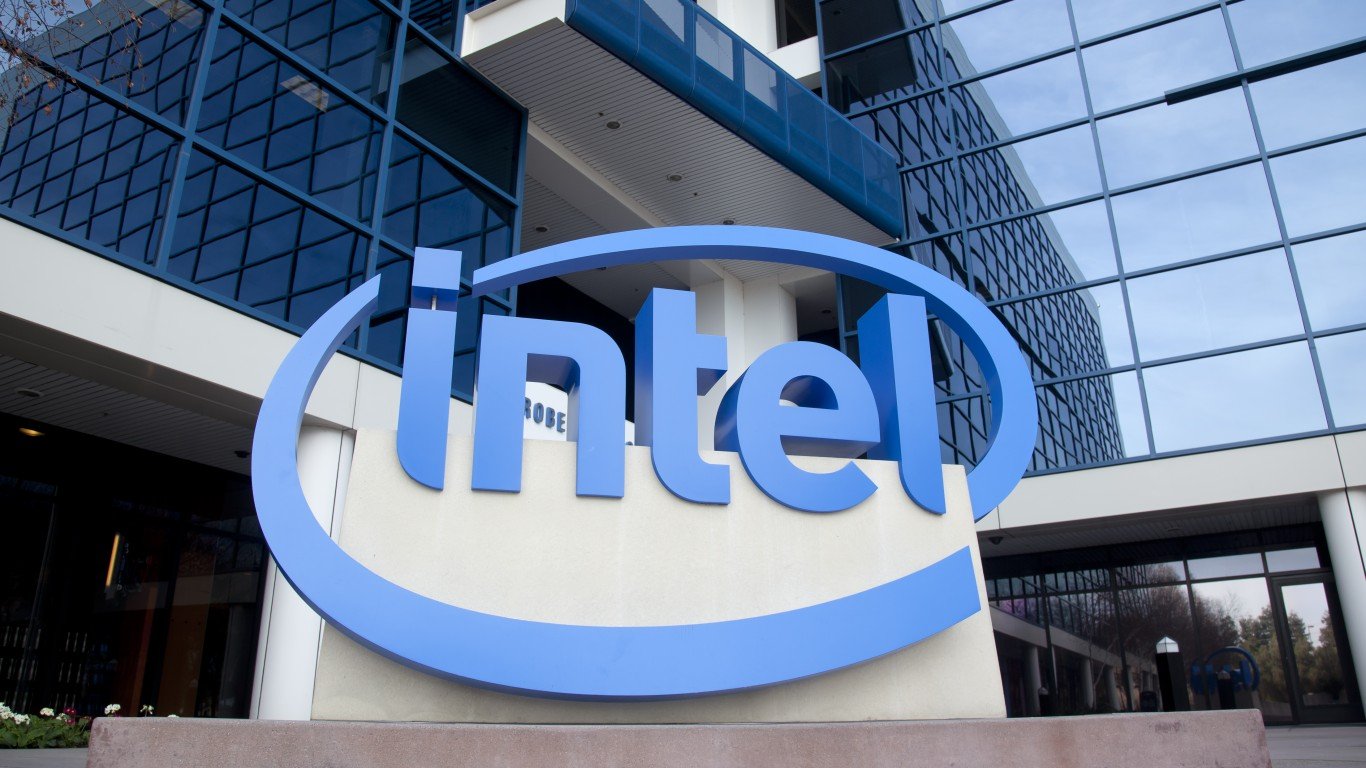
13. Intel: Still changing its stripes for the better
Intel Corp. (NASDAQ: INTC) may be changing to less of a personal computer component play than a decade or two ago, but it still faced several challenges in 2018. One was the resignation of CEO Brian Krzanich over an internal policy issue. That left Intel vulnerable to a leadership and development vacuum, considering other managers might might to jump ship. That said, Intel matters more in the broader market than in the Dow because it is the third lowest weight in the index at just over 1.3%. After a gain of 27.3% in 2017 (versus 13% expected), Intel’s mere 1.7% uptick in 2018 was less than analysts’ expected return of just 4.33%. With shares at $46.93, in a 52-week range of $42.04 to $57.60, the $54.34 consensus target price implies an expected gain of nearly 16% for 2019, before considering the 2.6% dividend yield. Rather than lowering targets and expectations, Bank of America Merrill Lynch raised Intel to Buy from Neutral and lifted its price target up to $60 from $52.
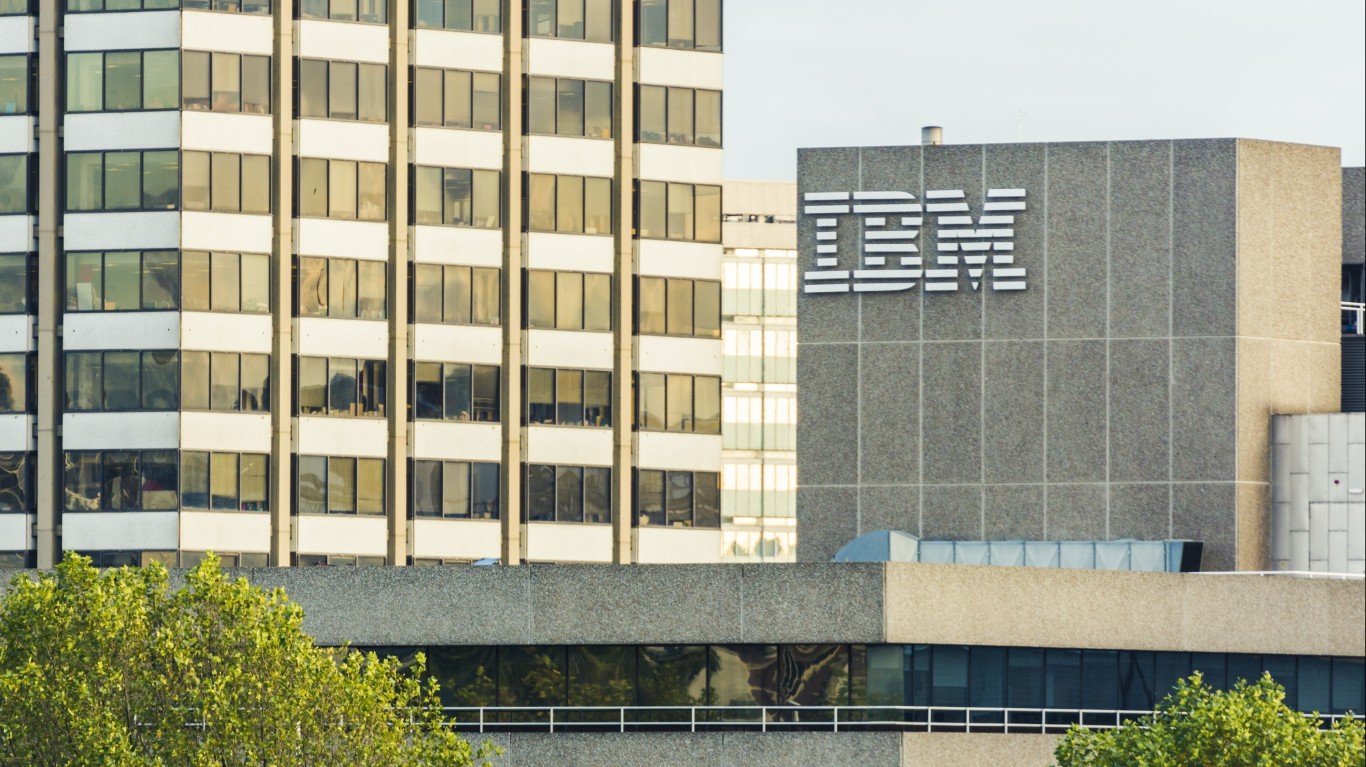
14. IBM: Continued disappointment
International Business Machines Corp. (NYSE: IBM) is a tech company that just cannot get a break, even when it acquired Red Hat to become the No. 1 hybrid cloud provider. Year after year, IBM continues to disappoint, as the company struggles to make up for the decline in its core IT services business with stock buybacks and increased dividends. Its growth areas of cloud, artificial intelligence, machine learning, and other high-growth segments cannot make up for the difference yet.
IBM stock lost almost 26% of its value in 2018, and that was after a negative return of 7.6% in 2017. IBM stock traded at $113.67 a share by 2018’s end, in a 52-week range of $105.94 to $171.13. Analysts still somehow have a consensus price target of $149.58 on Big Blue that implies an expected gain of 31.6%, before considering that 5.5% dividend yield. More analysts are likely to trim their targets if IBM does not rapidly recover in 2019.
[in-text-ad-2]
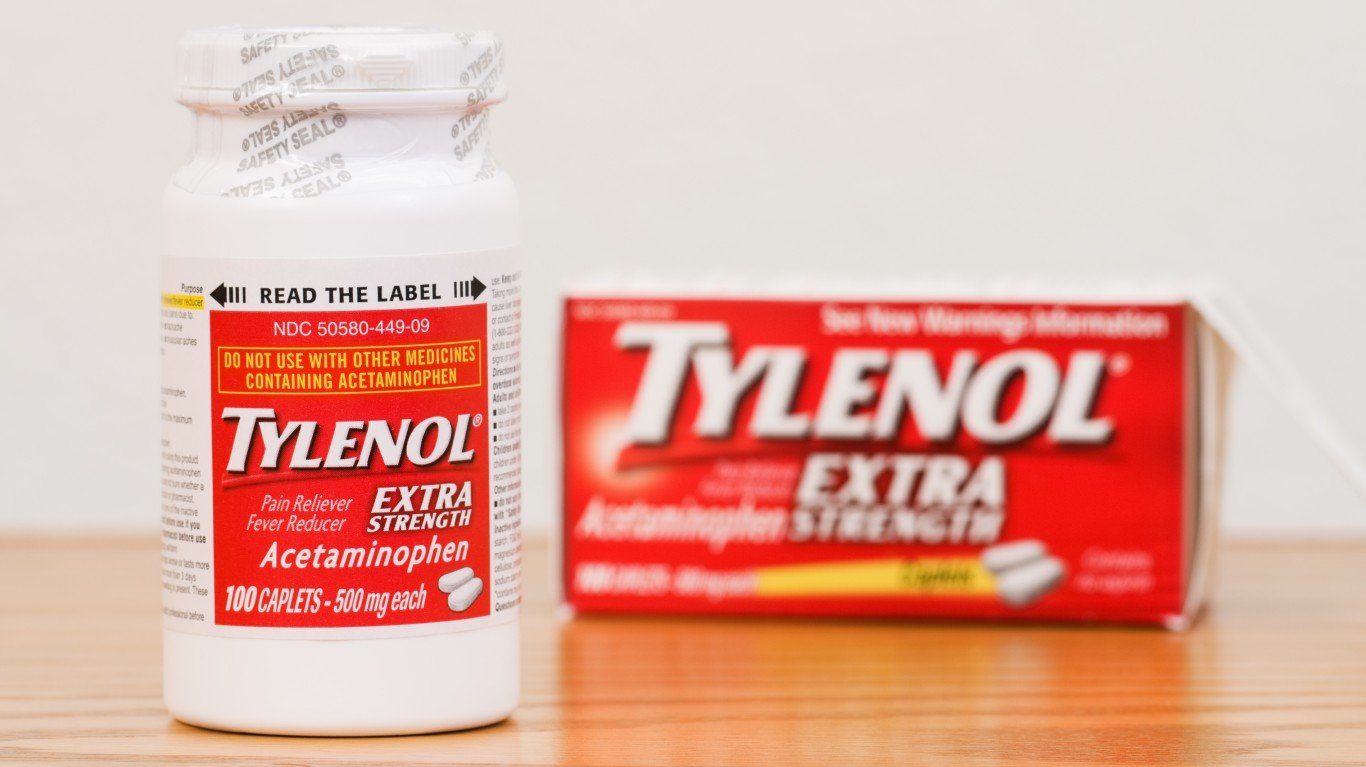
15. Johnson & Johnson: Dealing with asbestos scandal
Johnson & Johnson (NYSE: JNJ) stock lost more than 7% of its value in 2018, after it had a total return of over 21% in 2017. The stock consensus target price of $148.17 is higher than the consensus target price of $146.82 a year earlier. At $129.05 a share, Johnson & Johnson is down from a high of $148.17 before the story about its asbestos-tainted talcum powder broke and created an unknown and incalculable financial risk for the medical devices and consumer products conglomerate. With shares at $129.05 at the end of 2018, analysts are looking for a total return of 17.6%, including the 2.8% dividend yield. On Jan. 2, Morgan Stanley maintained its Equal Weight rating but lowered its price target to $130 from $153. Citi maintained its Neutral rating while it lowered its target to $139 from $148.
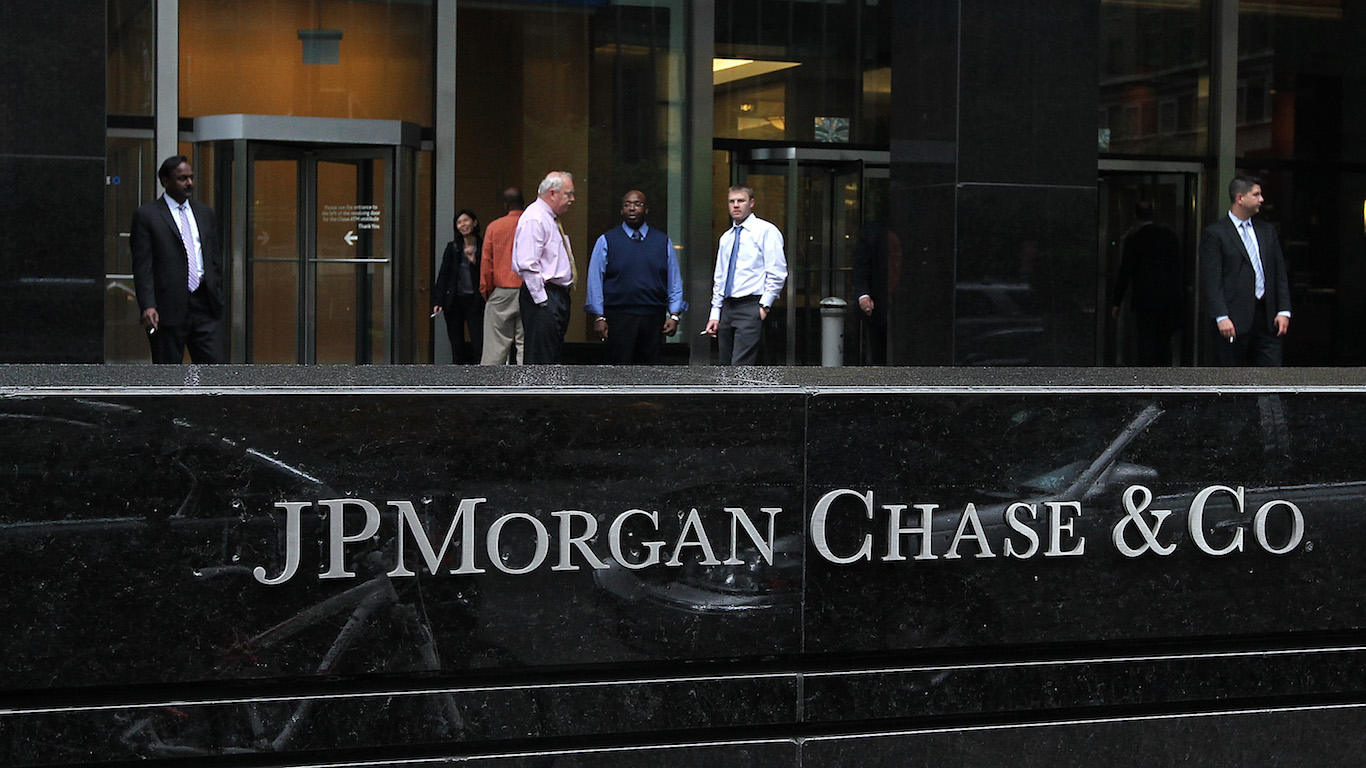
16. JPMorgan: Deregulation booster turned south
JPMorgan Chase & Co. (NYSE: JPM), led by deregulation advocate Jamie Dimon, blew out expectations in 2017, with shares returning almost 24%, when analysts were originally expected a -1.1% return. But in 2018, the bank’s share price dropped by 8.7%. The deregulation efforts of the last two years have not been enough to keep the bank’s share price higher as worries over the overall economy, future bank profits, and increased competition in the sector are adding to the anxiety over a flattening — possibly inverting — yield curve.
The stock traded at $97.62 at the end of the year, and the consensus price target of $120.07 is significantly higher than the consensus target of $104.23 from a year earlier. The 3.3% juiced-up dividend yield would imply a total return of 26.3%, that is, if the pool of analysts is proved to be correct.
[in-text-ad]

17. McDonald’s: Valuation and revamp
McDonald’s Corp. (NYSE: MCD) had greatly recovered from its woes of several years ago and it has an ambitious shareholder capital return plan. That said, the fast-food king stock finished up only 3.2% in 2018, after generating a return of over 41% in 2017. The revamping of the stores and meals comes at a time when employees are seeking higher wages, and McDonald’s has invested in non-personnel technology such as ordering kiosks. It is also unclear if the McDonald’s effort to remove artificial ingredient for more “pure” and fresh food will succeed in the coming years.
Shares traded at $177.57 at the end of 2018, and the consensus price target of $195.44 is substantially higher than the $179.79 consensus target from a year earlier. The price target, including McDonald’s dividend yield of 2.6%, would generate a total return of 12.7% in 2019 — if analysts are right.
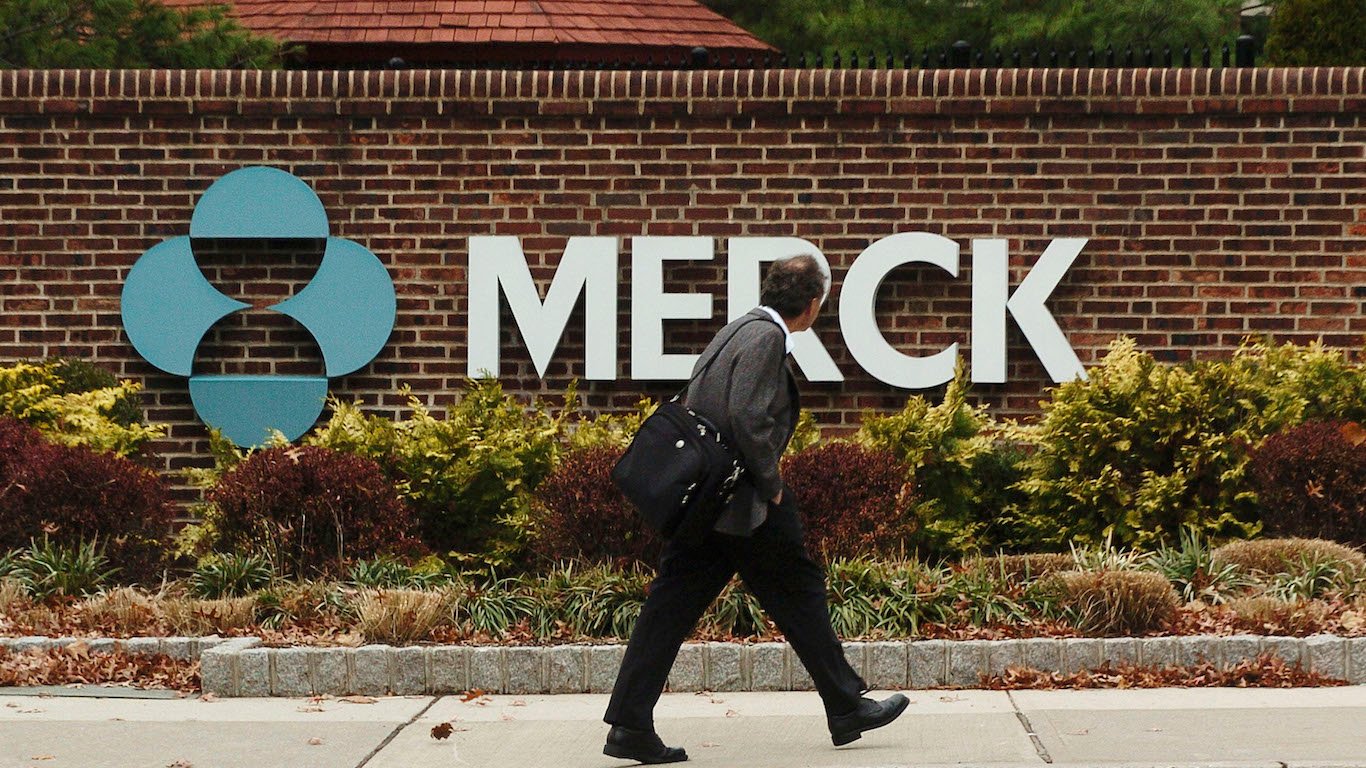
18. Merck: From Big Pharma to top dog
Merck & Co Inc. (NYSE: MRK) was the best performing Dow stock of 2018 with a 35.8% gain, boosted by a strong pipeline of drugs, including the cancer treatment Keytruda. That is after a disappointing -4.4% return in 2017. The pharmaceutical giant is viewed as a defensive stock in a choppy market, but it may come under pressure because of talk by politicians about drug-price controls. The shares traded at $76.41 at the end of 2018 with a 52-week range of $52.83 to $80.19. The consensus price target of $81.01 and the stock’s 2.9% yield would generate an expected total return of 8.9%, if analysts are forecasting accurately.
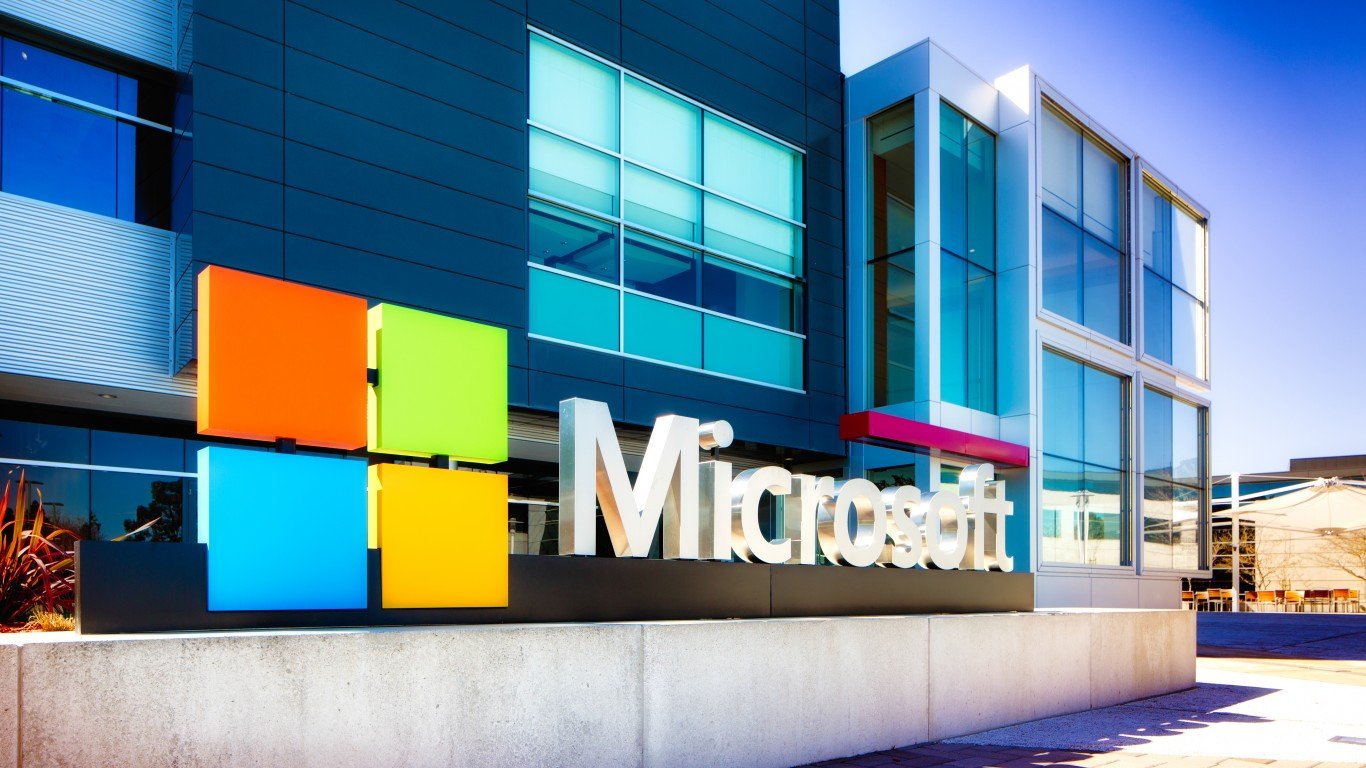
19. Microsoft: Floating happily in the cloud
Microsoft Corp. (NASDAQ: MSFT) stock ended 2018 up an impressive 18.7%, after it soared 37.7% in 2017, blowing out expectations of that time. Microsoft shares also broke out above their dot-com bubble highs from almost two decades ago as CEO Satya Nadella’s shift to cloud and subscription services has been very well received. Shares closed out 2018 at $101.57, in a 52-week range of $83.83 to $116.18. The software and cloud giant’s stock consensus target price of $125.39 is up from a consensus target of $92.75 a year earlier. Its dividend yield of 1.8% is now lower than a year earlier because of the stock price appreciation, but analysts following the company expect a total return of just over 25% for 2019.
[in-text-ad-2]
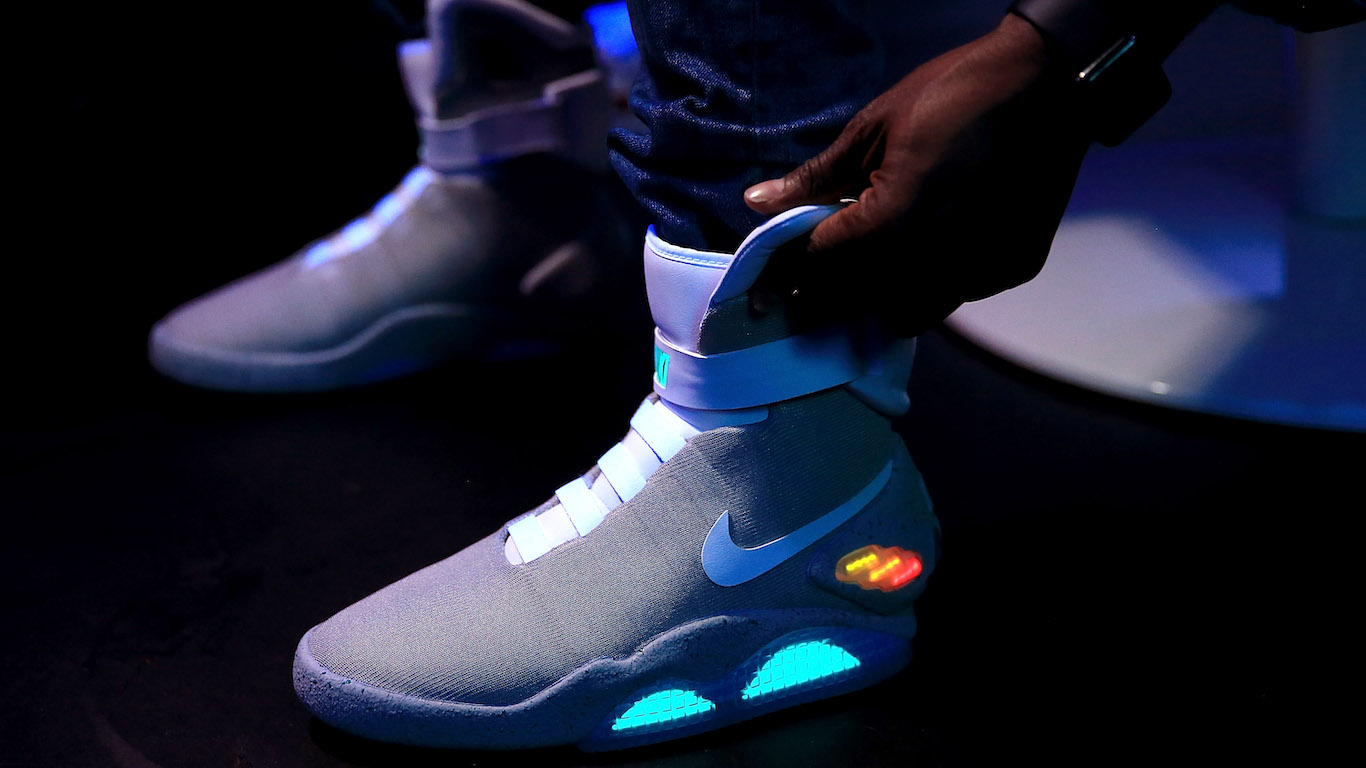
20. Nike: Recovery after a reboot
Nike Inc. (NYSE: NKE) managed to close 2018 up 18.5%, after a total return of 23.1% in 2017. With trade war concerns and emerging markets showing less growth, the question is whether the athletic footwear company can “just do it” again for a third year. After shares closed out 2018 at $74.14, the consensus target price of $86.44 is well above the consensus target price of $64.65 from a year earlier. With the 1.2% dividend yield, the target price implies an almost 18% expected total return in 2019.
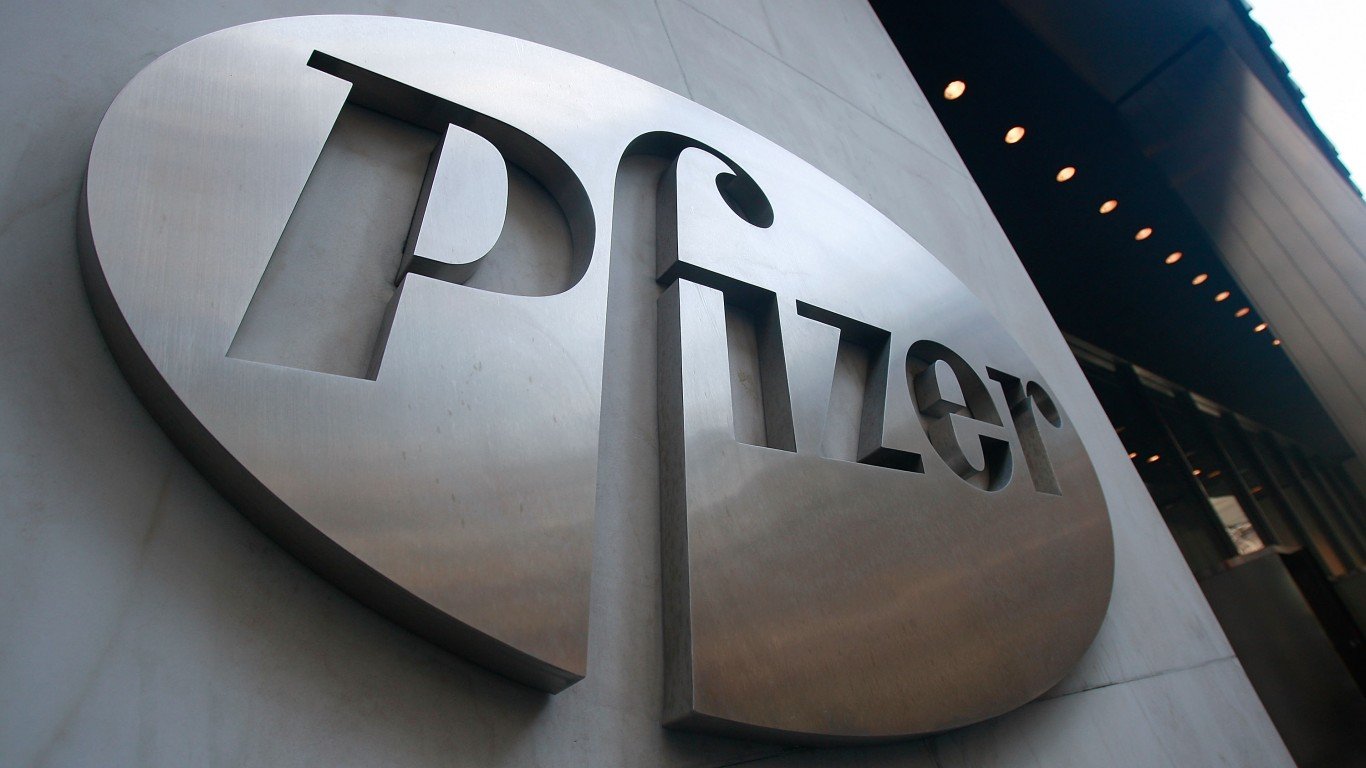
21. Pfizer: Big Pharma’s No. 2
Pfizer Inc. (NYSE: PFE) stock turned in a gain of 20.5% in 2018, after a total return of 11.5% the previous year. While impressive, that is less than rival pharmaceutical rival Merck, which Pfizer had outperformed in 2017. Analysts consider Pfizer to be a defensive and safer stock in a turbulent market, but there is anxiety in the pharmaceutical industry about price regulation pushed by some legislators in Congress. Analysts also may  be concerned that the company may not be able to follow up its strong performance of 2018. Pfizer’s year-end price of $43.65 comes with a consensus price target of $45.32 and a yield of 3.3%%, for an expected 2019 total return of about 7%.
[in-text-ad]

22. Procter & Gamble: Beyond competitive pressure
Procter & Gamble Co. (NYSE: PG) had floundered because of international and competitive pressures on the consumer products company, but with a reboot happening in its portfolio and with the stock market favoring defensive names, its shares rallied back to finish unchanged in 2018. Shares traded at $91.92 at year’s end, below P&G’s year-earlier consensus price target was $93.53. The new year consensus price target of $90.88 would imply a 1.1% drop in the share price, before adding in the solid 3.1% dividend yield.
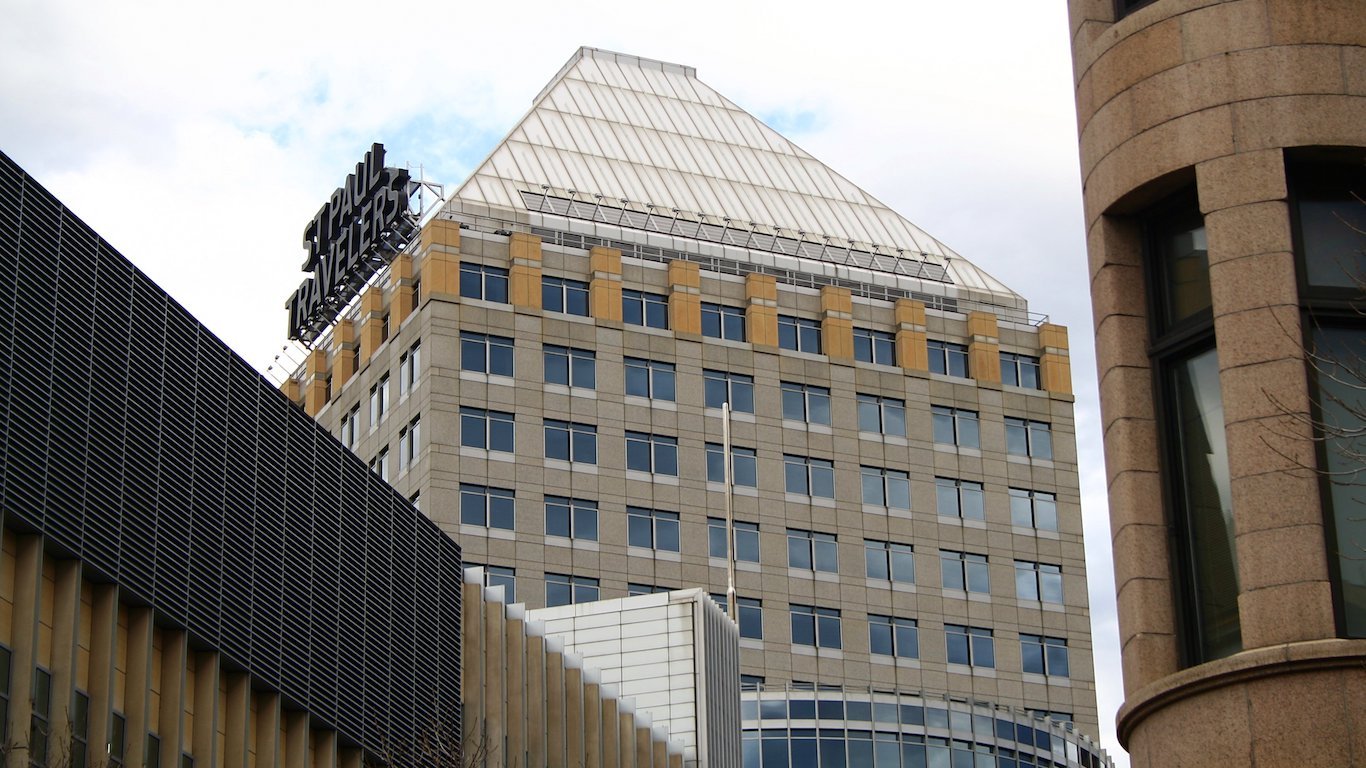
23. Travelers: The forgotten Dow stock
Most investors probably often forget that Travelers Companies Inc. (NYSE: TRV) is a member of the Dow Jones Industrial Average. The shares lost 11.7% in 2018, after gaining 10.8% in 2017. Analysts were only looking for a return of about 2% in 2018, but the weakness in the financial sector weighed on Travelers and the stock missed even that modest expectation. Investors have to hope that a flattening or an inverting yield curve would not harm insurance companies as much as it could hurt the banks.
The insurance and financial giant closed out 2018 at $119.75 a share, down from a 52-week high of $150.55. The year-ahead consensus target price of $136.06 is very similar to last year’s target of $135.31. If analysts are correct, the 2.6% yield would help investors get a return better than 16% in 2019.
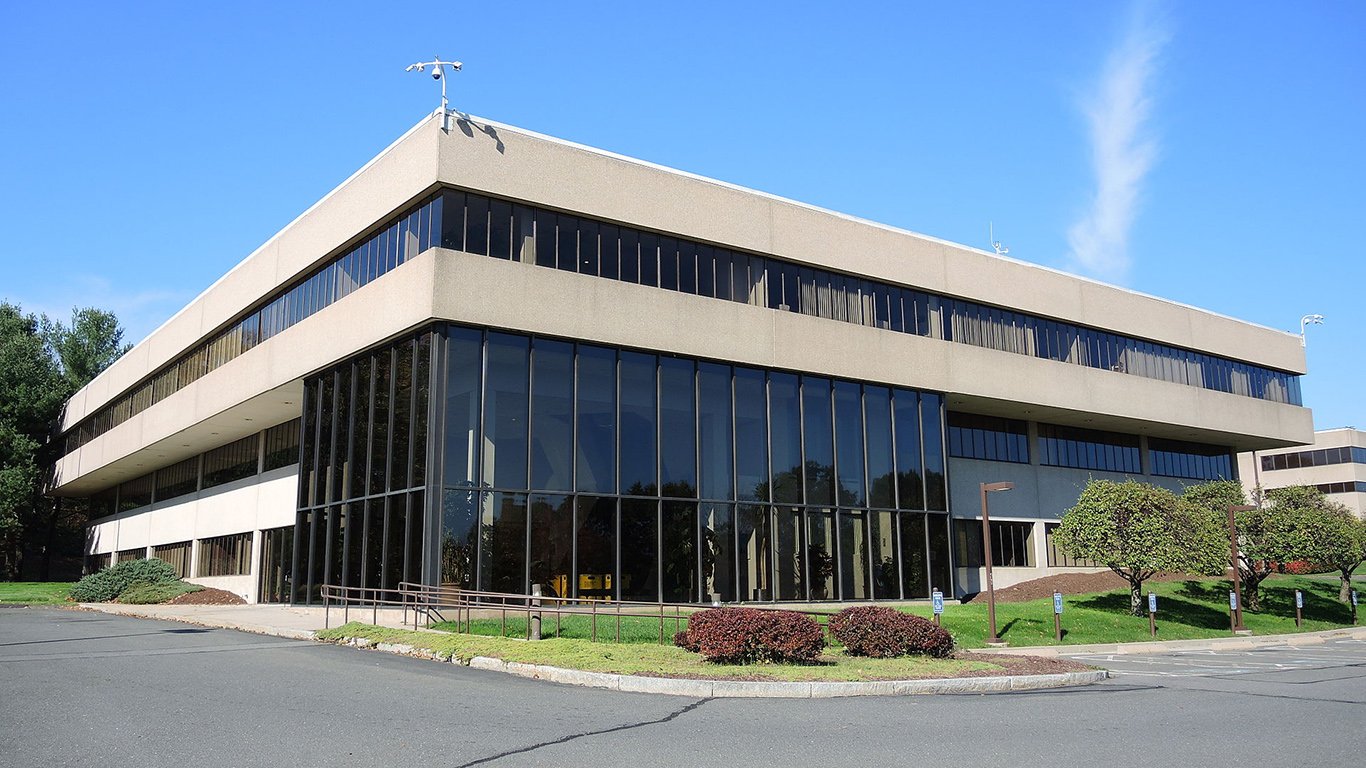
24. United Tech: From M&A ambitions to a breakup
United Technologies Corp. (NYSE: UTX) is a Dow stock that is about to undergo major changes. UTC, once a would-be acquirer, is breaking up into three companies: Otis elevators, Carrier HVAC and building systems, and United Technologies aerospace and defense business. The market cap of UTC was valued at less than $100 billion as of the end of 2018. That could mean it might not even be a Dow stock after 2019, but it is still early to consider such a scenario.
Unfortunately, the timing of the breakup news in late November was around the time equity markets began their selloff, and the overall reaction was not that positive from many analysts and investors. UTC shares lost 16.5% of their value in 2018. The stock traded at $106.48 at the end of 2018, down from a 52-week high of $144.15. The $146.13 consensus target price implies an expected gain of 37.2%, before taking the 2.8% dividend into consideration. With a weakened market and an obvious distraction during a long breakup process, it seems like that analysts will further chop some targets and expectations in 2019. The Royal Bank of Canada did this on Friday, downgrading UTC to Sector Perform from Outperform and lowered its target price to $119 from $139.
[in-text-ad-2]

25. UnitedHealth: Health insurance sure pays well!
UnitedHealth Group Inc. (NYSE: UNH) stock generated a 13% return for shareholders in 2018, lifted by the health-care company’s Optum health services business and its insurance division. Despite a rough market this was a tad better than the 11.9% return analysts expected a year ago. The country’s largest private health insurer managed to generate a total return of 37.8% in 2017, versus expectations of just 13.5%. It traded at $249.12 a share as of the end of the year, with a 52-week range of $208.48 to $287.94. UnitedHealth’s consensus target price of $309.82 offers an implied 24.4% return for 2019, if analysts are correct, and that is without considering its 1.5% dividend yield.
UnitedHealth is the second most important Dow stock with a 7% weighting in the index.
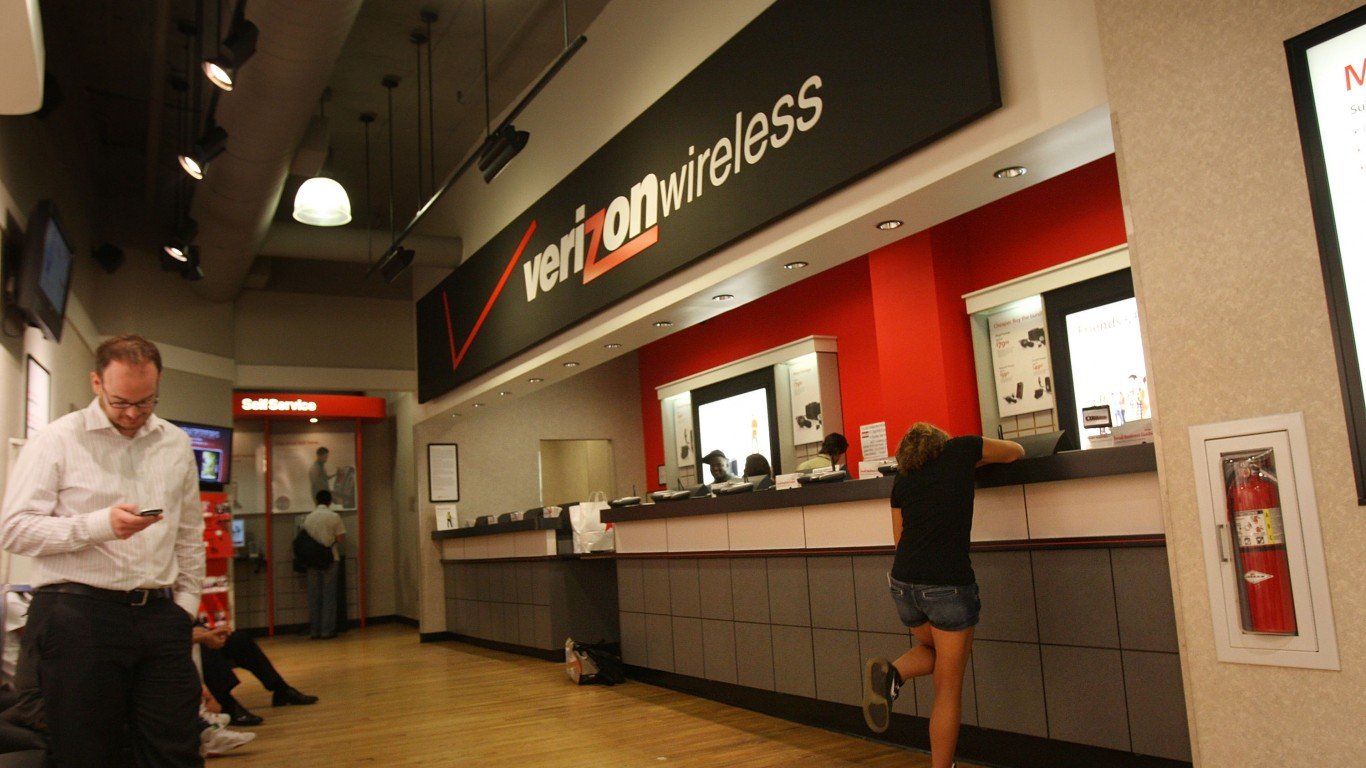
26. Verizon: Top Dow telecom
Verizon Communications Inc. (NYSE: VZ) is now the sole telecom giant in the Dow. After a boring â0.8% return in 2017, Verizon stock rose 6.2% in 2018. Its price of $56.22 at the end of the year was trading in a 52-week range of $46.09 to $61.58. The 2019 consensus price target is $58.70, for an implied 4.4% share price gain, or an 8.7% total return including the stock’s 4.3% dividend yield. 24/7 Wall St. thought analysts underestimated Verizon after the shares staged a big second-half rally in 2017 to nearly make up losses for the year, and 2018 carried on that momentum. Though it has acquired some internet properties, Verizon remains truer to a wireless carrier rather than AT&T, which diversified with AT&T with DirecTV and Time Warner. There has been some turnover and underperformance inside of its Oath unit (Yahoo and AOL), but Verizon still owns and controls some of the nation’s top portals used by millions of Americans each day.
[in-text-ad]

27. Visa: Still riding credit card transaction game
Visa Inc. (NYSE: V) does not necessarily care what kind of transaction card holders make when they use its credit card because Visa gets a piece of the action either way via transaction fees. It just wants more shoppers and buyers to use Visa. The stock’s 46% return in 2017 was more than double the expectations, and its 15.7% return in 2018 also was higher than the total return expectation of 9.8%. The stock, which traded at $131.94 a share as of year-end in a 52-week range of $111.02 to $151.56, has a consensus target price of $163.56, which implies a gain of $23.9% for 2019. Visa could stand to do increase its dividend yield, as it is the weakest of the 30 Dow stocks at just 0.7%.
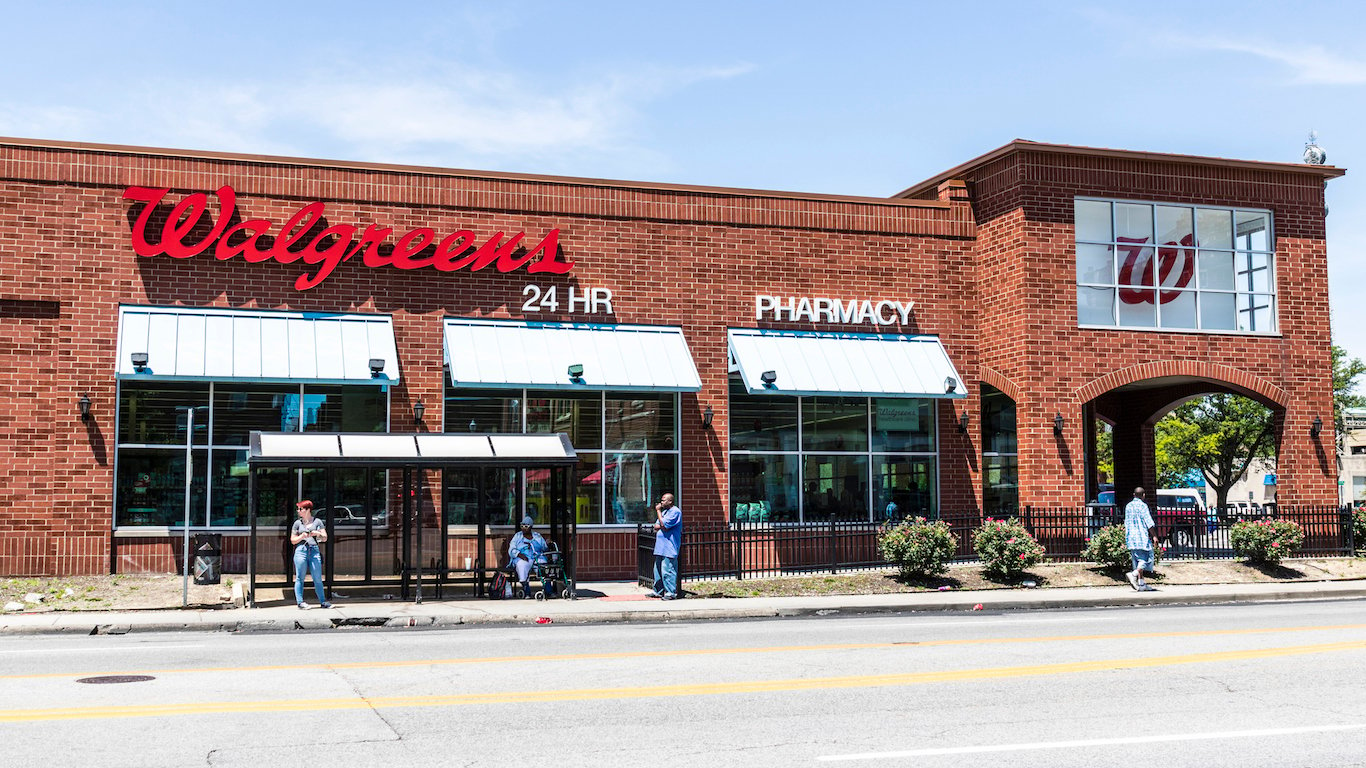
28. Walgreens Boots Alliance: Tough time to join the Dow
Walgreens Boots Alliance Inc. (NASDAQ: WBA) is the newest member of the Dow. Shares of the pharmacy store chain turned in a negative performance of 5.9% for all of 2018. The pharma-seller and drugstore chain has been under serious pressure with rival pharmacies merging with insurance companies and other parts of the drug-supply chain. At $68.33 a share as of the end of 2018, Walgreens accounts for just a hair under 2% of the Dow weighting. Its 52-week trading range is $59.07 to $86.31, and the consensus target price of $77.74 would imply a gain of 13.8% in 2019. The total return, after adding in a 2.6% dividend yield, would be 16.4%.
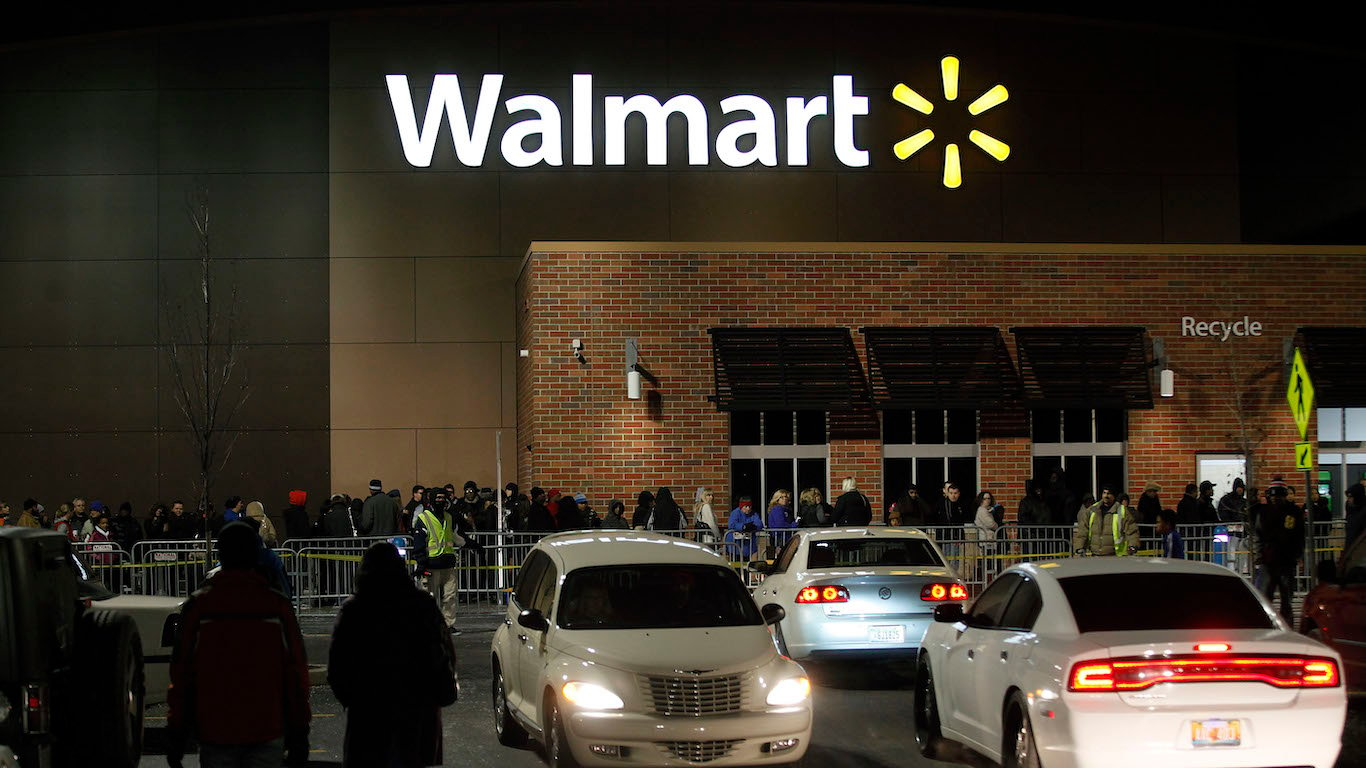
29. Walmart: Winning-ish in an anti-Amazon fight
Walmart Inc. (NYSE: WMT) had a rough end to 2018 after it never found its footing following  the November 2018 earnings report. The company reported quarterly revenue missed expectations and the shares slid. They continued to decline with the weak stock market into year’s end. Closing out 2018 at $93.15, the shares have a 52-week range of $81.78 to $109.98, and the stock lost about 6% of its value in 2018. The consensus analyst target price of $107.00, implies and expected gain of 14.8% in 2019, but that is without considering its 2.2% yield. The world’s largest brick-and-mortar retailer is frequently considered to be one of the few likely “Amazon-proof” retailers, and it is making its own progress in the e-commerce world as well.
[in-text-ad-2]

30. Walt Disney: M&A changes continue away from Mickey
Walt Disney Co. (NYSE: DIS) slipped 2.4% in 2018, compared with the 5.8% gain projected a year ago. While the entertainment company transformed itself with its acquisitions of Pixar, Marvel, and Star Wars, it has transformed itself even more via the acquisition of the 21st Century Fox assets. Disney said  it expected to pay a total of about $35.7 billion in cash and issue about 343 million new Disney shares to 21st Century Fox stockholders. The then-current 21st Century Fox stockholders were projected to own a stake of between 17% and 20% in the new Disney
Disney also has a large stake in the streaming service Hulu, and maybe all these changes will take the focus of the analyst community away from the future of ESPN. Shares traded at $109.65 at the end of 2018, and the $124.50 consensus target price implies a projected gain of 13.5% in 2019, or a total return of 15.1% after adding in the 1.6% dividend yield.
Sponsored: Want to Retire Early? Here’s a Great First Step
Want retirement to come a few years earlier than you’d planned? Or are you ready to retire now, but want an extra set of eyes on your finances?
Now you can speak with up to 3 financial experts in your area for FREE. By simply clicking here you can begin to match with financial professionals who can help you build your plan to retire early. And the best part? The first conversation with them is free.
Click here to match with up to 3 financial pros who would be excited to help you make financial decisions.
Thank you for reading! Have some feedback for us?
Contact the 24/7 Wall St. editorial team.
 24/7 Wall St.
24/7 Wall St.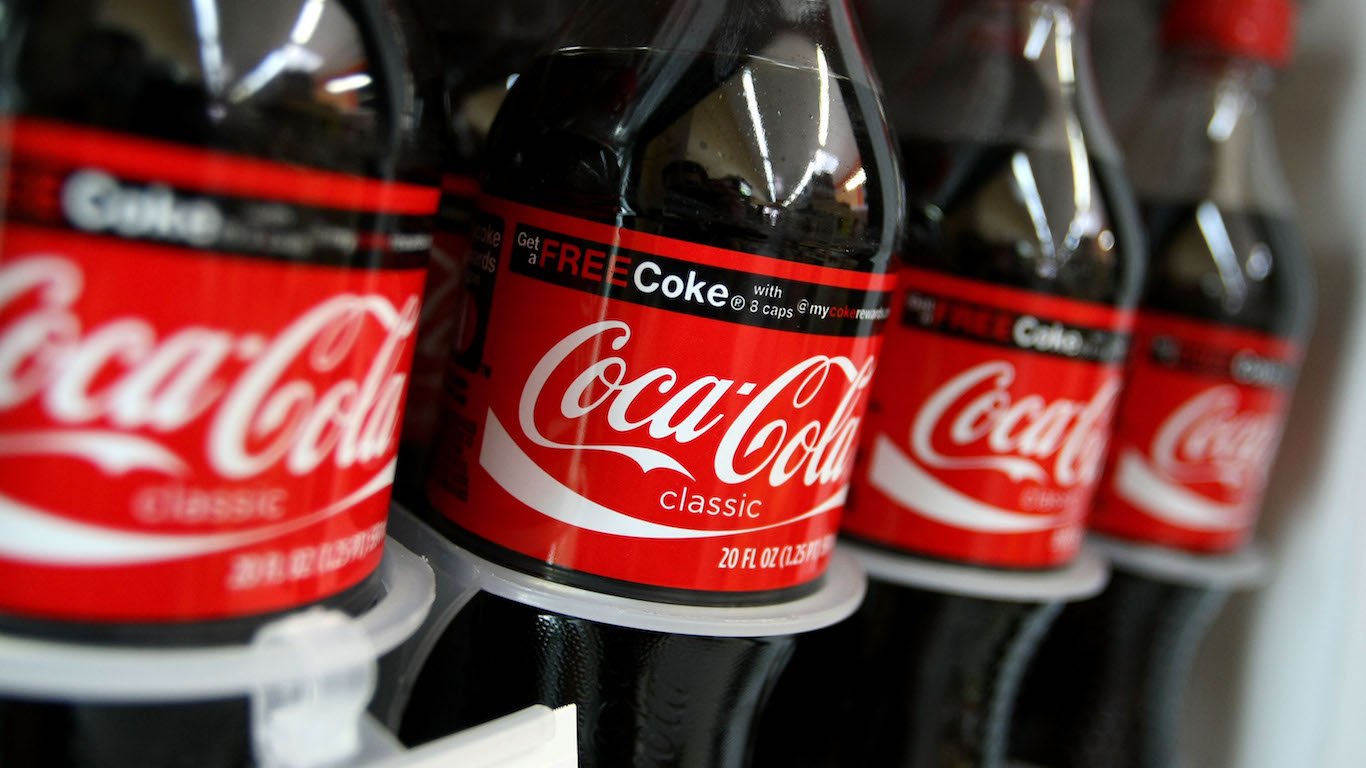 24/7 Wall St.
24/7 Wall St.
